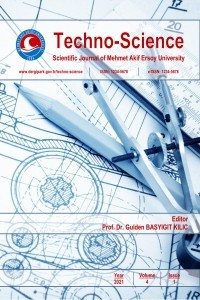A novel n-pivot macrocyclic ligand and its Cobalt(II) phthalocyanine derivative: synthesis, characterization and extractant properties
A novel n-pivot macrocyclic ligand and its Cobalt(II) phthalocyanine derivative: synthesis, characterization and extractant properties
Phthalocyanine, Macrocycle, N-Pivot Transition metal, Solvent extraction,
___
- [1]. Pedersen, C. J. (1967). Cyclic polyethers and their complexes with metal salts. Journal of the American Chemical Society vol. 89 p. 7017-7065, DOI: 10.1021/ja01002a035.
- [2]. An, H., Bradshaw, J. S., Izatt, R. M. (1992). Macropolycyclic polyethers and related compounds. Chemical Reviews vol. 92, no. 4, p. 543-572, DOI: 10.1021/cr00012a004.
- [3]. Yordanov, A.T. Roundhill, D.M. (1998). Solution extraction of transition and post-transition heavy and precious metals by chelate and macrocyclic ligands. Coordination Chemistry Reviews vol. 170, no. 1, p. 93–124, DOI: 10.1016/S0010-8545(97)00074-X
- [4]. Lindoy, L. F. (1989). The chemistry of macrocyclic ligand complexes. Cambridge: Cambridge University Press.
- [5]. Hancock, R. D, Martell, A. E. (1989). Ligand design for selective complexetion of metal ions in aqueous solution. Chemical Reviews vol. 89, no. 8, p. 1875-1914. DOI: 10.1021/cr00098a011
- [6]. Byrne, G. T., Linstead, R. P., Lowe. (1934). Phthalocyanines. Part II. The Preparation of Phthalocyanine and Some Metallic Derivatives from o-Cyanobenzamide and Phthalimide. Journal of Chemical Society, p. 1017-1022. DOI: 10.1039/JR9340001017
- [7]. Allen, C. M., Sharman, W. M., Van Lier, J. E. (2001). Current status of phthalocyanines in the photodynamic therapy of cancer. Journals of Porphyrins and Phthalocyanines v. 5, no. 2, p.161-169, DOI:10.1002/jpp.324.
- [8]. Cho, K.T., Trukhina, O., Roldán-Carmona, C., Ince, M., Gratia, P., Grancini, G., Gao, P., Marszalek, T., Pisula, W., Reddy, P.Y., Torres, T., Nazeeruddin, M.K. (2017). Molecularly Engineered Phthalocyanines as Hole-Transporting Materials in Perovskite Solar Cells Reaching Power Conversion Efficiency of 17.5%. Advenced Energy Materials vol. 7, 1601733, DOI: 10.1002/aenm.201601733.
- [9]. Koray, A. R., Ahsen, V., Bekaroğlu, Ö. (1986). Preparation of a novel, soluble copper phthalocyanine with crown ether moieties. Journal of the Chemical Society, Chemical Communication p. 932-933. DOI: 10.1039/C39860000932.
- [10]. Musluoğlu, E., Ahsen, V., Gül, A., Bekaroğlu, Ö. (1991). Water-soluble phthalocyanines containing aza-crown ether substituents. Chemiche Berichte vol. 124, no. 11, p. 2531-2536. DOI: 10.1002/cber.19911241123.
- [11]. Gök, H. Z., Kantekin, H., Gök, Y., Herman G. (2007). The synthesis and characterization of novel metal-free and metallo-phthalocyanines bearing four 27-membered dioxadiazapentathia macrocycles. Dyes and Pigments, Vol.74, no. 3, p. 699-705. DOI: 10.1016/j.dyepig.2006.05.002.
- [12]. Gök, H.Z. (2015). Synthesis of metal-free and metallophthalocyanines containing 18- and 21-membered macrocycles with mixed donor atoms and their metal-ion binding properties. Turkish Journal of Chemistry vol. 39, p. 750-763, DOI: 10.3906/kim-1501-54.
- [13]. Gök, H. Z., Alp, H., Kantekin, H., Ocak, Ü. (2007). The synthesis and characterization of 22-membered diazapentathia macrocycles and investigation of their ion extraction capability from aqueous media. Transition Metal Chemistry vol. 32, no. 8, p. 1073-1078, DOI: 10.1007/s11243-007-0290-7.
- [14]. Alp, H., Gök, H. Z., Kantekin, H., Ocak, Ü. (2008). Synthesis and metal ion binding properties of thiaaza crown macrocycles, Journal of Hazardous Materials vol. 159, no. 2-3, p. 519-522, DOI: 10.1016/j.jhazmat.2008.02.093.
- [15]. Gök, H. Z., Gök, Y. (2017). Synthesis, characterization and metal-ion binding properties of a new macrobicyclic ligand with dioxadiazaoctathia donor atoms. Heteroatom Chemistry vol. 28, e21374; https://doi.org/10.1002/hc.21374
- [16]. Alp, H., Bıyıklıoğlu, Z., Ocak, M., Ocak, Ü., Kantekin, H., Dilber, G. (2007). New heavy metal ion‐selective macrocyclic ligands with nitrogen and sulfur donor atoms and their extractant properties. Separation Science and Technology vol. 42, no.4, p. 835-845 DOI: 10.1080/01496390601174000.
- [17]. Kantekin, H., Kılıçaslan, M. B., Ağın, F., Alp, H., Ocak, Ü. (2010). New heavy metal ion-selective macrocyclic ligands with mixed-donor atoms and their extractant properties. Journal of Coordination Chemistry vol. 63, no. 11, p. 1921-1932, DOI: 10.1080/00958972.2010.494303.
- [18]. Gök H. Z., Farsak B. (2013). Synthesis, characterisation and aggregation properties of novel metal-free and metallophthalocyanines containing four 21-membered oxatetrathiadiaza macrocycles. Journal of Organometallic Chemistry vol. 735, p. 65-71, DOI: 10.1016/j.jorganchem.2013.03.019.
- [19]. Perrin, D. D., Armarego , W. L. F. (1989). Purification of laboratory chemicals. 2nd ed. Oxford: Pergamon Press.
- [20]. Demirayak, N., Akkuş, F., Gök Y. (2013). Synthesis and characterization of a new zinc phthalocyanine containing macrobicyclic moieties. Inorganic Chemistry Communication vol. 37, p. 97-100, DOI: 10.1016/j.inoche.2013.09.050
- Yayın Aralığı: Yılda 2 Sayı
- Başlangıç: 2018
- Yayıncı: Burdur Mehmet Akif Ersoy Üniversitesi
Production of biogas as an energy source in colder area, using flat plate thermal collector
Naqeeb Ullah KAKAR, Jafar Khan KASİ, Ajab Khan KASİ, Samiullah TAREEN
Fabrication of microinjector system (SIM) using anodic aluminum oxide
